Environmental Impacts on Soil and Groundwater of Informal E-Waste Recycling Processes in Ghana
Abstract
1. Introduction
1.1. Literature Review
1.1.1. The Global E-Waste Challenge
1.1.2. Managing E-Waste in Ghana and the Role of the Informal Sector
1.1.3. Environmental Impact of Informal E-Waste Recycling
1.2. Knowledge Gap and Research Question
- How do informal e-waste recycling activities contribute to soil contamination?
- How do informal e-waste recycling processes affect the quality of groundwater?
- What is the environmental impact of informal e-waste processes regarding soil and groundwater pollution?
- Which informal e-waste recycling processes need to be improved in order to derive effective measures for mitigating pollution?
1.3. Objectives
- Investigating the contamination in soil and groundwater with heavy metals and organic pollutants arising from informal e-waste recycling processes;
- identifying the processes which offer the best potential for improvement;
- contributing to informed decision-making on informal e-waste recycling processes.
2. Materials and Methods
2.1. Study Area and Geology
2.2. Sampling
2.3. Sample Analysis
2.4. Contamination Indices and Data Processing
3. Results
3.1. Soil Contamination
3.2. Water Cocontamination
3.3. Relationship between Informal E-Waste Reycling and Soil and Groundwater Pollution
3.4. Informal E-Waste Processes with Highest Pollutant Indices
4. Discussion
4.1. General Findings
4.1.1. Sources and Impact of Informal E-Waste Recycling to Soil Contamination
4.1.2. Relation between Groundwater Contamination and Informal E-Waste Recycling
4.1.3. Environmental Impacts of Informal E-Waste Recycling Processes on Soil and Groundwater
4.1.4. Possible Strategies in Mitigating Pollution from Informal E-Waste Recycling Practices in Ghana
4.2. Categorisation of Results among Other Studies
4.3. Limitations
5. Conclusions
Supplementary Materials
Author Contributions
Funding
Institutional Review Board Statement
Informed Consent Statement
Data Availability Statement
Acknowledgments
Conflicts of Interest
References
- Baldé, A.C.P.; Kuehr, R.; Yamamoto, T.; Mcdonald, R.; Angelo, E.D.; Althaf, S.; Bel, G.; Deubzer, O.; Fernandez-cubillo, E.; Forti, V.; et al. The Global E-Waste Monitor 2024; International Telecommunication Union (ITU): Geneva, Switzerland; United Nations Institute for Training and Research (UNITAR): Bonn, German, 2024; ISBN 9789261387815. [Google Scholar]
- Heacock, M.; Kelly, C.B.; Asante, K.A.; Birnbaum, L.S.; Bergman, Å.L.; Bruné, M.N.; Buka, I.; Carpenter, D.O.; Chen, A.; Huo, X.; et al. E-Waste and Harm to Vulnerable Populations: A Growing Global Problem. Environ. Health Perspect. 2016, 124, 550–555. [Google Scholar] [CrossRef] [PubMed]
- Perkins, D.N.; Brune Drisse, M.N.; Nxele, T.; Sly, P.D. E-Waste: A Global Hazard. Ann. Glob. Health 2014, 80, 286–295. [Google Scholar] [CrossRef]
- Dave, S.R.; Shah, M.B.; Tipre, D.R. E-Waste: Metal Pollution Threat or Metal Resource? J. Adv. Res. Biotechnol. 2016, 1, 1–14. [Google Scholar] [CrossRef]
- Brigden, K.; Johnston, P.; Santillo, D.; Labunska, I. Chemical Contamination at E-Waste Recycling and Disposal Sites in Accra and Korforidua, Ghana. Greenpeace Research Laboratories. 2008, p. 24. Available online: https://www.greenpeace.to/publications/chemical-contamination-at-e-wa.pdf (accessed on 28 March 2024).
- Widmer, R.; Oswald-Krapf, H.; Sinha-Khetriwal, D.; Schnellmann, M.; Böni, H. Global Perspectives on E-Waste. Environ. Impact Assess. Rev. 2005, 25, 436–458. [Google Scholar] [CrossRef]
- Tsydenova, O.; Bengtsson, M. Chemical Hazards Associated with Treatment of Waste Electrical and Electronic Equipment. Waste Manag. 2011, 31, 45–58. [Google Scholar] [CrossRef]
- Liu, K.; Tan, Q.; Yu, J.; Wang, M. A Global Perspective on E-Waste Recycling. Circ. Econ. 2023, 2, 100028. [Google Scholar] [CrossRef]
- Osibanjo, O.; Nnorom, I.C. The Challenge of Electronic Waste (e-Waste) Management in Developing Countries. Waste Manag. Res. 2007, 25, 489–501. [Google Scholar] [CrossRef]
- Chi, X.; Streicher-Porte, M.; Wang, M.Y.L.; Reuter, M.A. Informal Electronic Waste Recycling: A Sector Review with Special Focus on China. Waste Manag. 2011, 31, 731–742. [Google Scholar] [CrossRef] [PubMed]
- Forti, V.; Baldé, C.P.; Kuehr, R.; Bel, G. The Global E-Waste Monitor 2020: Quantities, Flows and the Circular Economy Potential; United Nations University (UNU)/International Solid Waste Association (ISWA): Bonn/Geneva/Rotterdam, Switzerland, 2020; ISBN 9789280891140. [Google Scholar]
- Amoyaw-Osei, Y.; Agyekum, O.O.; Pwamang, J.A.; Mueller, E.; Fasko, R.; Schluep, M. Ghana E-Waste Country Assessment; Green Advocacy Ghana, EPA Ghana: Accra, Ghana; EMPA Switzerland: Dübendorf, Switzerland, 2011. [Google Scholar]
- Schluep, M.; Müller, E.; Hilty, L.M.; Ott, D.; Widmer, R.; Böni, H. Insights from a Decade of Development Cooperation in E-Waste Management. First Int. Conf. Inf. Commun. Technol. Sustain. 2013, 45–51, 223–230. [Google Scholar] [CrossRef]
- Grant, R.; Oteng-Ababio, M. Mapping the Invisible and Real “African” Economy: Urban E-Waste Circuitry. Urban Geogr. 2012, 33, 1–21. [Google Scholar] [CrossRef]
- Maes, T.; Preston-Whyte, F. E-Waste It Wisely: Lessons from Africa. SN Appl. Sci. 2022, 4, 1–12. [Google Scholar] [CrossRef] [PubMed]
- Odeyingbo, O.; Nnorom, I.; Deubzer, O. Person in the Port Project—Assessing Import of Used Electrical and Electronic Equipment into Nigeria; UNN: Tokyo, Japan, 2017; p. 35. [Google Scholar]
- Schluep, M.; Terekhova, T.; Manhart, A.; Muller, E.; Rochat, D.; Osibanjo, O. Where Are WEEE in Africa? In Proceedings of the Electronics Goes Green 2012+, Berlin, Germany, 9–12 September 2012; pp. 1–6. [Google Scholar]
- Prakash, S.; Manhart, A.; Amoyaw-Osei, Y.; Agyekum, O.O. Socio-Economic Assessment and Feasibility Study on Sustainable E-Waste Management in Ghana; Öko-Institut e.V.: Freiburg/Darmstadt/Berlin, Germany, 2010; Volume 49. [Google Scholar]
- Oteng-Ababio, M.; Amankwaa, E.F.; Chama, M.A. The Local Contours of Scavenging for E-Waste and Higher-Valued Constituent Parts in Accra, Ghana. Habitat Int. 2014, 43, 163–171. [Google Scholar] [CrossRef]
- Amankwaa, E.F. Livelihoods in Risk: Exploring Health and Environmental Implications of e-Waste Recycling as a Livelihood Strategy in Ghana. J. Mod. Afr. Stud. 2013, 51, 551–575. [Google Scholar] [CrossRef]
- Amankwaa, E.F. E-Waste Livelihoods, Environment and Health Risks: Unpacking the Connections in Ghana. West Afr. J. Appl. Ecol. 2014, 22, 1–15. [Google Scholar]
- Wilson, D.C.; Velis, C.; Cheeseman, C. Role of Informal Sector Recycling in Waste Management in Developing Countries. Habitat Int. 2006, 30, 797–808. [Google Scholar] [CrossRef]
- Owusu-Sekyere, K.; Alatule, D. Material Flow Analysis and Risk Evaluation of Informal E-Waste Recycling Processes in Ghana: Towards Sustainable Management Strategies. J. Clean. Prod. 2023, 430, 139706. [Google Scholar] [CrossRef]
- Kumi, E.; Hemkhaus, M.; Bauer, T. Money Dey for Borla: Assessment of Ghana’s E-Waste Value Chain; Adelphi: Berlin, Germany, 2019. [Google Scholar]
- Adanu, S.K.; Gbedemah, S.F.; Attah, M.K. Challenges of Adopting Sustainable Technologies in E-Waste Management at Agbogbloshie, Ghana. Heliyon 2020, 6, e04548. [Google Scholar] [CrossRef] [PubMed]
- Fevrier, K.M. Race and Waste: The Politics of Electronic Waste Recycling & Scrap Metal Recovery in Agbogbloshie, Accra, Ghana; York University: Toronto, ON, Canda, 2020. [Google Scholar]
- Awere, E.; Obeng, P.A.; Bonoli, A.; Obeng, P.A. E-Waste Recycling and Public Exposure to Organic Compounds in Developing Countries: A Review of Recycling Practices and Toxicity Levels in Ghana. Environ. Technol. Rev. 2020, 9, 1–19. [Google Scholar] [CrossRef]
- Wittsiepe, J.; Fobil, J.; Till, H.; Burchard, G.; Wilhelm, M.; Feldt, T. Levels of Polychlorinated Dibenzo-p-Dioxins, Dibenzofurans (PCDD/Fs) and Biphenyls (PCBs) in Blood of Informal e-Waste Recycling Workers from Agbogbloshie, Ghana, and Controls. Environ. Int. 2015, 79, 65–73. [Google Scholar] [CrossRef]
- Obiri, S.; Ansa-Asare, O.D.; Mohammed, S.; Darko, H.F.; Dartey, A.G. Exposure to Toxicants in Soil and Bottom Ash Deposits in Agbogbloshie, Ghana: Human Health Risk Assessment. Environ. Monit. Assess. 2016, 188, 1–9. [Google Scholar] [CrossRef]
- Orlins, S.; Guan, D. China’s Toxic Informal e-Waste Recycling: Local Approaches to a Global Environmental Problem. J. Clean. Prod. 2016, 114, 71–80. [Google Scholar] [CrossRef]
- Amponsah, L.O.; Sørensen, P.B.; Nkansah, M.A.; Vorkamp, K.; Yevugah, L.L.; Darko, G. Mercury Contamination of Two E-Waste Recycling Sites in Ghana: An Investigation into Mercury Pollution at Dagomba Line (Kumasi) and Agbogbloshie (Accra). Environ. Geochem. Health 2023, 45, 1723–1737. [Google Scholar] [CrossRef] [PubMed]
- Zheng, J.; Mittal, K.; Fobil, J.N.; Basu, N.; Bayen, S. Simultaneous Targeted and Non-Targeted Analysis of Plastic-Related Contaminants in e-Waste Impacted Soil in Agbogbloshie, Ghana. Sci. Total Environ. 2024, 917, 170219. [Google Scholar] [CrossRef] [PubMed]
- Akortia, E.; Olukunle, O.; Daso, A.; Okonkwo, J. Soil Concentrations of Polybrominated Diphenyl Ethers and Trace Metals from an Electronic Waste Dump Site in the Greater Accra Region, Ghana: Implications for Human Exposure. Ecotoxicol. Environ. Saf. 2017, 137, 247–255. [Google Scholar] [CrossRef] [PubMed]
- Atiemo, S.; Ofosu, F.; Aboh, K.; Kuranchie-Mensah, H. Assessing the Heavy Metals Contamination of Surface Dust from Waste Electrical and Electronic Equipment (E-Waste) Recycling Site in Accra. Res. J. Environ. Earth Sci. 2012, 4, 605–611. [Google Scholar]
- Caravanos, J.; Clark, E.; Fuller, R.; Lambertson, C. Assessing Worker and Environmental Chemical Exposure Risks at an E-Waste Recycling and Disposal Site in Accra, Ghana. J. Health Pollut. 2011, 1, 16–25. [Google Scholar] [CrossRef]
- Fujimori, T.; Itai, T.; Goto, A.; Asante, K.; Otsuka, M.; Takahashi, S.; Tanabe, S. Interplay of Metals and Bromine with Dioxin-Related Compounds Concentrated in e-Waste Open Burning Soil from Agbogbloshie in Accra, Ghana. Environ. Pollut. 2016, 209, 155–163. [Google Scholar] [CrossRef] [PubMed]
- Itai, T.; Otsuka, M.; Asante, K.A.; Muto, M.; Opoku-Ankomah, Y.; Ansa-Asare, O.D.; Tanabe, S. Variation and Distribution of Metals and Metalloids in Soil/Ash Mixtures from Agbogbloshie e-Waste Recycling Site in Accra, Ghana. Sci. Total Environ. 2014, 470–471, 707–716. [Google Scholar] [CrossRef] [PubMed]
- Kyere, V.N. Environmental and Health Impacts of Informal E-waste Recycling in Agbogbloshie, Accra, Ghana: Recommendations for Sustainable Management; Rheinische Friedrich-Wilhelms-Universität Bonn: Bonn, Germany, 2016. [Google Scholar]
- Daum, K.; Stoler, J.; Grant, R.J. Toward a More Sustainable Trajectory for E-Waste Policy: A Review of a Decade of e-Waste Research in Accra, Ghana. Int. J. Environ. Res. Public Health 2017, 14, 135. [Google Scholar] [CrossRef]
- Sepúlveda, A.; Schluep, M.; Renaud, F.G.; Streicher, M.; Kuehr, R.; Hagelüken, C.; Gerecke, A.C. A Review of the Environmental Fate and Effects of Hazardous Substances Released from Electrical and Electronic Equipments during Recycling: Examples from China and India. Environ. Impact Assess. Rev. 2010, 30, 28–41. [Google Scholar] [CrossRef]
- Orisakwe, O.E.; Frazzoli, C.; Ilo, C.E.; Oritsemuelebi, B. Public Health Burden of E-Waste in Africa. J. Health Pollut. 2020, 9, 1–12. [Google Scholar] [CrossRef] [PubMed]
- Amankwaa, E.F.; Adovor Tsikudo, K.A.; Bowman, J. ‘Away’ Is a Place: The Impact of Electronic Waste Recycling on Blood Lead Levels in Ghana. Sci. Total Environ. 2017, 601–602, 1566–1574. [Google Scholar] [CrossRef] [PubMed]
- Ackah, M. Soil Elemental Concentrations, Geoaccumulation Index, Non-Carcinogenic and Carcinogenic Risks in Functional Areas of an Informal e-Waste Recycling Area in Accra, Ghana. Chemosphere 2019, 235, 908–917. [Google Scholar] [CrossRef] [PubMed]
- German Federal Ministry of Justice. German Federal Soil Protection Act; German Federal Ministry of Justice: Berlin, Germany, 1998; pp. 1–34.
- Tue, N.M.; Goto, A.; Takahashi, S.; Itai, T.; Asante, K.A.; Kunisue, T.; Tanabe, S. Release of Chlorinated, Brominated and Mixed Halogenated Dioxin-Related Compounds to Soils from Open Burning of e-Waste in Agbogbloshie (Accra, Ghana). J. Hazard. Mater. 2016, 302, 151–157. [Google Scholar] [CrossRef] [PubMed]
- Hilberg, S. Environmental Geology—An Introduction to Basics and Practice; Springer: Berlin, Germany, 2015; ISBN 9783662469477. [Google Scholar]
- Xie, Z.; Diao, S.; Xu, R.; Wei, G.; Wen, J.; Hu, G.; Tang, T.; Jiang, L.; Li, X.; Li, M.; et al. Construction of Carboxylated-GO and MOFs Composites for Efficient Removal of Heavy Metal Ions. Appl. Surf. Sci. 2023, 636, 157827. [Google Scholar] [CrossRef]
- Nishimura, C.; Horii, Y.; Tanaka, S.; Asante, K.A.; Ballesteros, F.; Viet, P.H.; Itai, T.; Takigami, H.; Tanabe, S.; Fujimori, T. Occurrence, Profiles, and Toxic Equivalents of Chlorinated and Brominated Polycyclic Aromatic Hydrocarbons in E-Waste Open Burning Soils. Environ. Pollut. 2017, 225, 252–260. [Google Scholar] [CrossRef] [PubMed]
- Bimir, M.N. Revisiting E-Waste Management Practices in Selected African Countries. J. Air Waste Manag. Assoc. 2020, 70, 659–669. [Google Scholar] [CrossRef]
- Ezeah, C.; Fazakerley, J.A.; Roberts, C.L. Emerging Trends in Informal Sector Recycling in Developing and Transition Countries. Waste Manag. 2013, 33, 2509–2519. [Google Scholar] [CrossRef]
- Andeobu, L.; Wibowo, S.; Grandhi, S. Informal E-Waste Recycling Practices and Environmental Pollution in Africa: What Is the Way Forward? Int. J. Hyg. Environ. Health 2023, 252, 114192. [Google Scholar] [CrossRef]
- Velis, C.A.; Hardesty, B.D.; Cottom, J.W.; Wilcox, C. Enabling the Informal Recycling Sector to Prevent Plastic Pollution and Deliver an Inclusive Circular Economy. Environ. Sci. Policy 2022, 138, 20–25. [Google Scholar] [CrossRef]
- Owusu-Sekyere, K.; Batteiger, A.; Afoblikame, R.; Hafner, G.; Kranert, M. Assessing Data in the Informal E-Waste Sector: The Agbogbloshie Scrapyard. Waste Manag. 2022, 139, 158–167. [Google Scholar] [CrossRef] [PubMed]
- World Bank Group. Climate Change Knowledge Portal. Available online: https://climateknowledgeportal.worldbank.org/ (accessed on 28 March 2024).
- Afoakwa, E. Report on Soil Testing Program at the Old Fadama Scrapyard near Central Business Area of Accra, Ghana. Accra, Ghana, 2020, Unpublished.
- Nyarku, M.; Ganyaglo, S.Y.; Glover, E.T.; Serfor-Armah, Y. Major Elements and Lithostratigraphic Study of the Contact Rocks of the Togo and the Dahomeyan Formations in Ghana. Nat. Sci. 2011, 3, 646–650. [Google Scholar] [CrossRef][Green Version]
- Atakorah, G.B.; Owusu, A.B.; Adu-Boahen, K. Geophysical Assessment of Flood Vulnerability of Accra Metropolitan Area, Ghana. Environ. Sustain. Indic. 2023, 19, 100286. [Google Scholar] [CrossRef]
- Hillel, D. Introduction to Soil Physics; Academic Press: San Diego, CA, USA, 1982. [Google Scholar]
- USDA. Soil Classification Design Infiltration Rates. Available online: https://stormwater.pca.state.mn.us/index.php/Design_infiltration_rates (accessed on 1 May 2024).
- Geotechdata. Information: Soil Void Ratio. Available online: https://geotechdata.info/parameter/void-ratio (accessed on 1 May 2024).
- Dekongmen, B.W.; Kabo-bah, A.T.; Domfeh, M.K.; Sunkari, E.D.; Dile, Y.T.; Antwi, E.O.; Gyimah, R.A.A. Flood Vulnerability Assessment in the Accra Metropolis, Southeastern Ghana. Appl. Water Sci. 2021, 11, 1–10. [Google Scholar] [CrossRef]
- Adesokan, M.D.; Adie, G.U.; Osibanjo, O. Soil Pollution by Toxic Metals near E-Waste Recycling Operations in Ibadan, Nigeria. J. Health Pollut. 2016, 6, 26–33. [Google Scholar] [CrossRef] [PubMed]
- Luo, C.; Liu, C.; Wang, Y.; Liu, X.; Li, F.; Zhang, G.; Li, X. Heavy Metal Contamination in Soils and Vegetables near an E-Waste Processing Site, South China. J. Hazard. Mater. 2011, 186, 481–490. [Google Scholar] [CrossRef] [PubMed]
- Moeckel, C.; Breivik, K.; Nøst, T.H.; Sankoh, A.; Jones, K.C.; Sweetman, A. Soil Pollution at a Major West African E-Waste Recycling Site: Contamination Pathways and Implications for Potential Mitigation Strategies. Environ. Int. 2020, 137, 105563. [Google Scholar] [CrossRef] [PubMed]
- DIN EN ISO 17294-2; Water Quality—Application of Inductively Coupled Plasma Mass Spectrometry (ICP-MS)—Part 2: Determination of Selected Elements Including Uranium Isotopes (ISO 17294-2:2023). IOS: Geneva, Switzerland, 2024.
- DIN EN 15936; Sludge, Treated Biowaste, Soil and Waste—Determination of Total Organic Carbon (TOC) by Dry Combustion. German Institute for Standardisation: Berlin, Germany, 2012.
- Wu, Q.; Leung, J.Y.S.; Geng, X.; Chen, S.; Huang, X.; Li, H.; Huang, Z.; Zhu, L.; Chen, J.; Lu, Y. Heavy Metal Contamination of Soil and Water in the Vicinity of an Abandoned E-Waste Recycling Site: Implications for Dissemination of Heavy Metals. Sci. Total Environ. 2015, 506–507, 217–225. [Google Scholar] [CrossRef] [PubMed]
- Swain, C.K. Environmental Pollution Indices: A Review on Concentration of Heavy Metals in Air, Water, and Soil near Industrialization and Urbanisation. Discov. Environ. 2024, 2, 1–14. [Google Scholar] [CrossRef]
- Kowalska, J.B.; Mazurek, R.; Gąsiorek, M.; Zaleski, T. Pollution Indices as Useful Tools for the Comprehensive Evaluation of the Degree of Soil Contamination–A Review. Environ. Geochem. Health 2018, 40, 2395–2420. [Google Scholar] [CrossRef]
- Hakanson, L. An Ecological Risk Index for Aquatic Pollution Control.a Sedimentological Approach. Water Res. 1980, 14, 975–1001. [Google Scholar] [CrossRef]
- Muller, G. Index of Geoaccumulation in Sediments of the Rhine River. GeoJournal 1969, 2, 108–118. [Google Scholar]
- Canadian Council of Ministers of the Environment. Canadian Water Quality Guidelines for the Protection of Aquatic Life; Canadian Council of Ministers of the Environment: Winnipeg, MB, Canada, 2017. [Google Scholar]
- Uddin, M.G.; Nash, S.; Olbert, A.I. A Review of Water Quality Index Models and Their Use for Assessing Surface Water Quality. Ecol. Indic. 2021, 122, 107218. [Google Scholar] [CrossRef]
- Zhan, M.; Wang, T.; Yang, J.; Ji, L.; Zhou, G.; Chen, T.; Li, X.; Lin, X. The Behaviors and Relationships of PCDD/Fs and Chlorobenzenes in the Whole Process of One Municipal Solid Waste Incinerator. Aerosol Air Qual. Res. 2018, 18, 3134–3146. [Google Scholar] [CrossRef]
- Sherene, T. Mobility and Transport of Heavy Metals in Polluted Soil Environment. Biol. Forum Int. J. 2010, 2, 112–121. [Google Scholar]
- Harfadli, M.M.; Ramadan, B.S.; Rachman, I.; Matsumoto, T. Challenges and Characteristics of the Informal Waste Sector in Developing Countries: An Overview. J. Mater. Cycles Waste Manag. 2024, 26, 1294–1309. [Google Scholar] [CrossRef]
- Oteng-Ababio, M. The Role of the Informal Sector in Solid Waste Management in the Gama, Ghana: Challenges and Opportunities. Tijdschr. Econ. Soc. Geogr. 2012, 103, 412–425. [Google Scholar] [CrossRef]
- Wilson, D.C.; Velis, C.A.; Rodic, L. Integrated Sustainable Waste Management in Developing Countries. Proceedings of the Institution of Civil Engineers: Waste and Resource Management. Proc. Inst. Civ. Eng. Waste Resour. Manag. 2013, 166, 52–68. [Google Scholar]
- Cao, P.; Fujimori, T.; Juhasz, A.; Takaoka, M.; Oshita, K. Bioaccessibility and Human Health Risk Assessment of Metal(Loid)s in Soil from an e-Waste Open Burning Site in Agbogbloshie, Accra, Ghana. Chemosphere 2020, 240, 124909. [Google Scholar] [CrossRef]
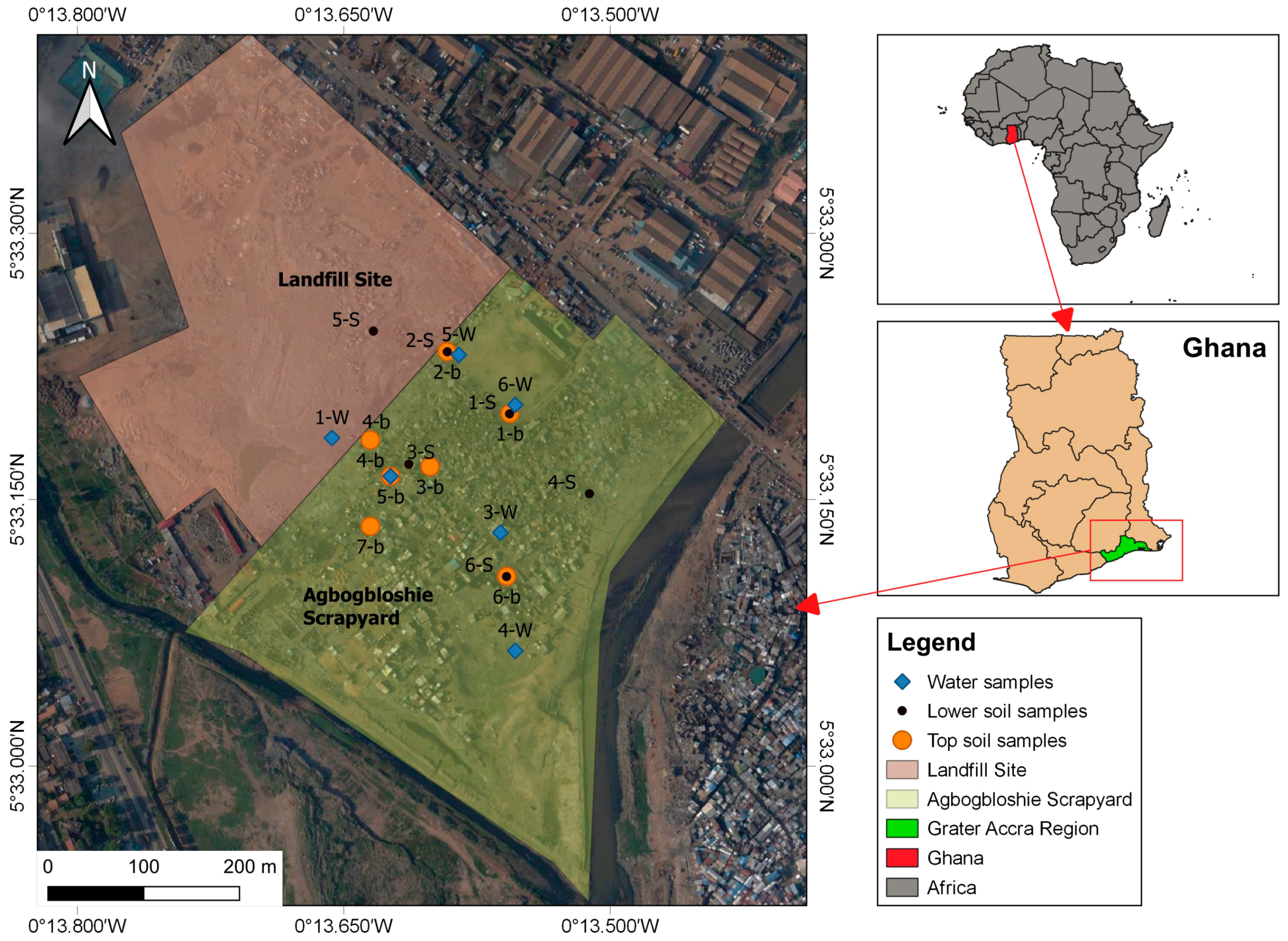
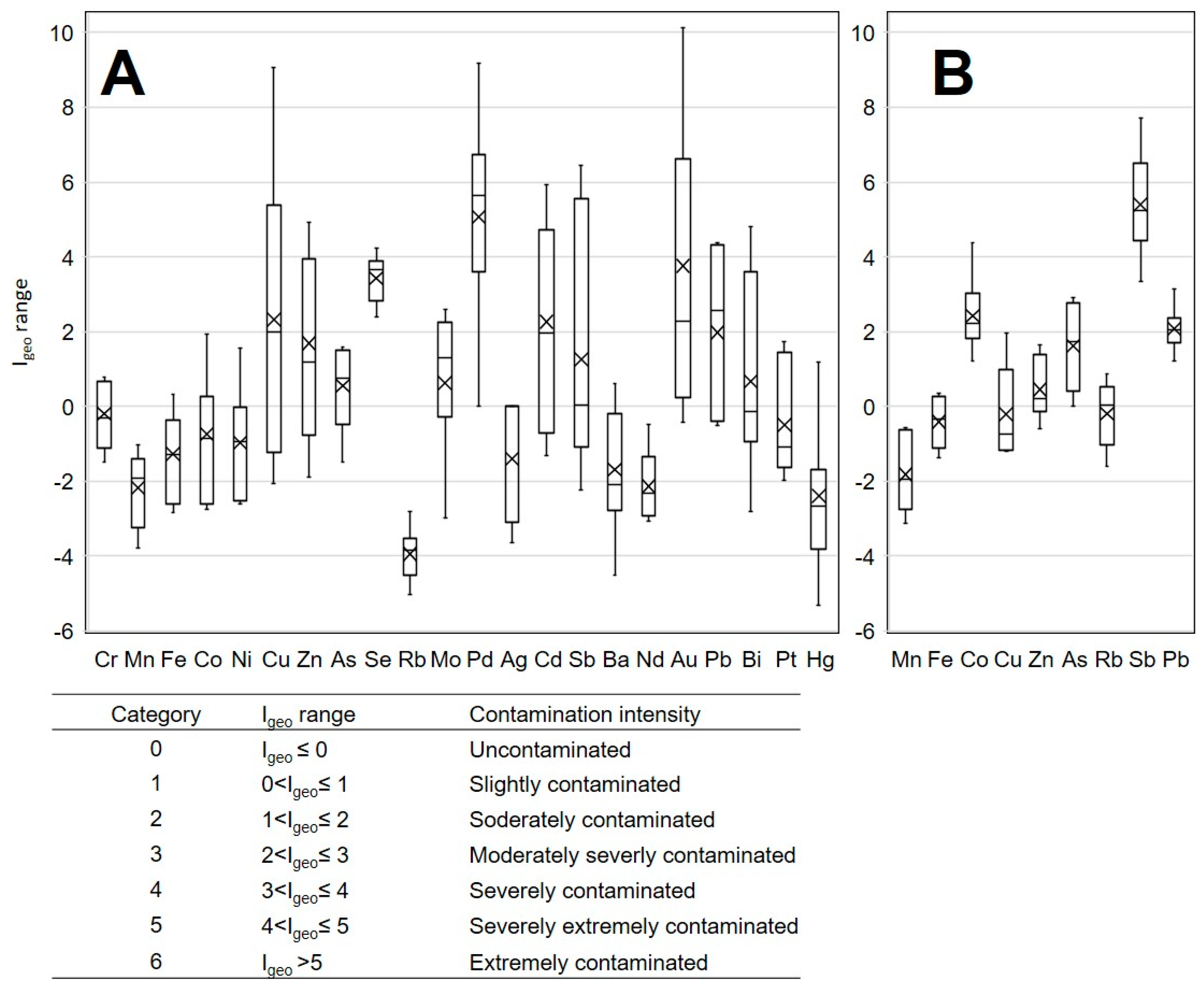
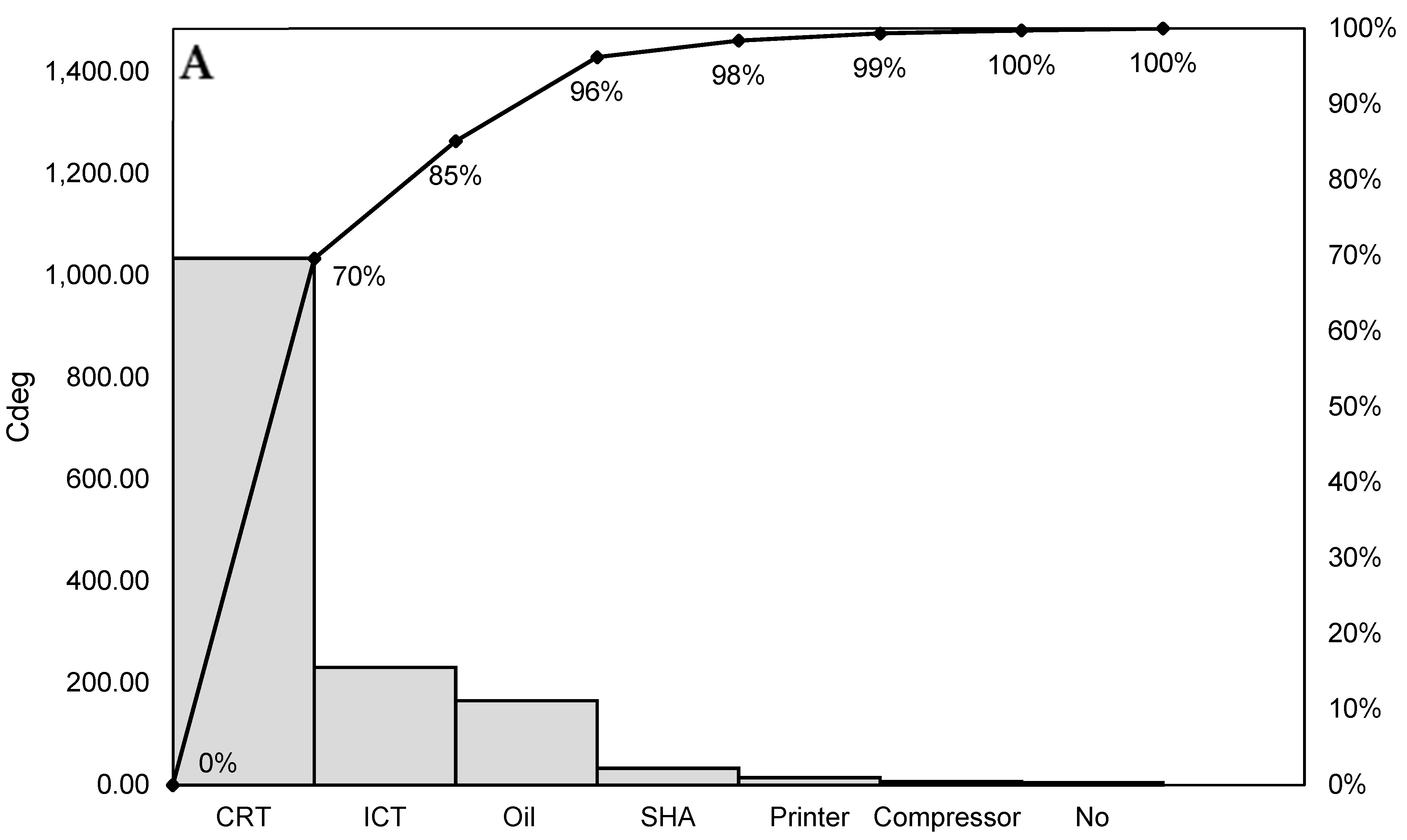
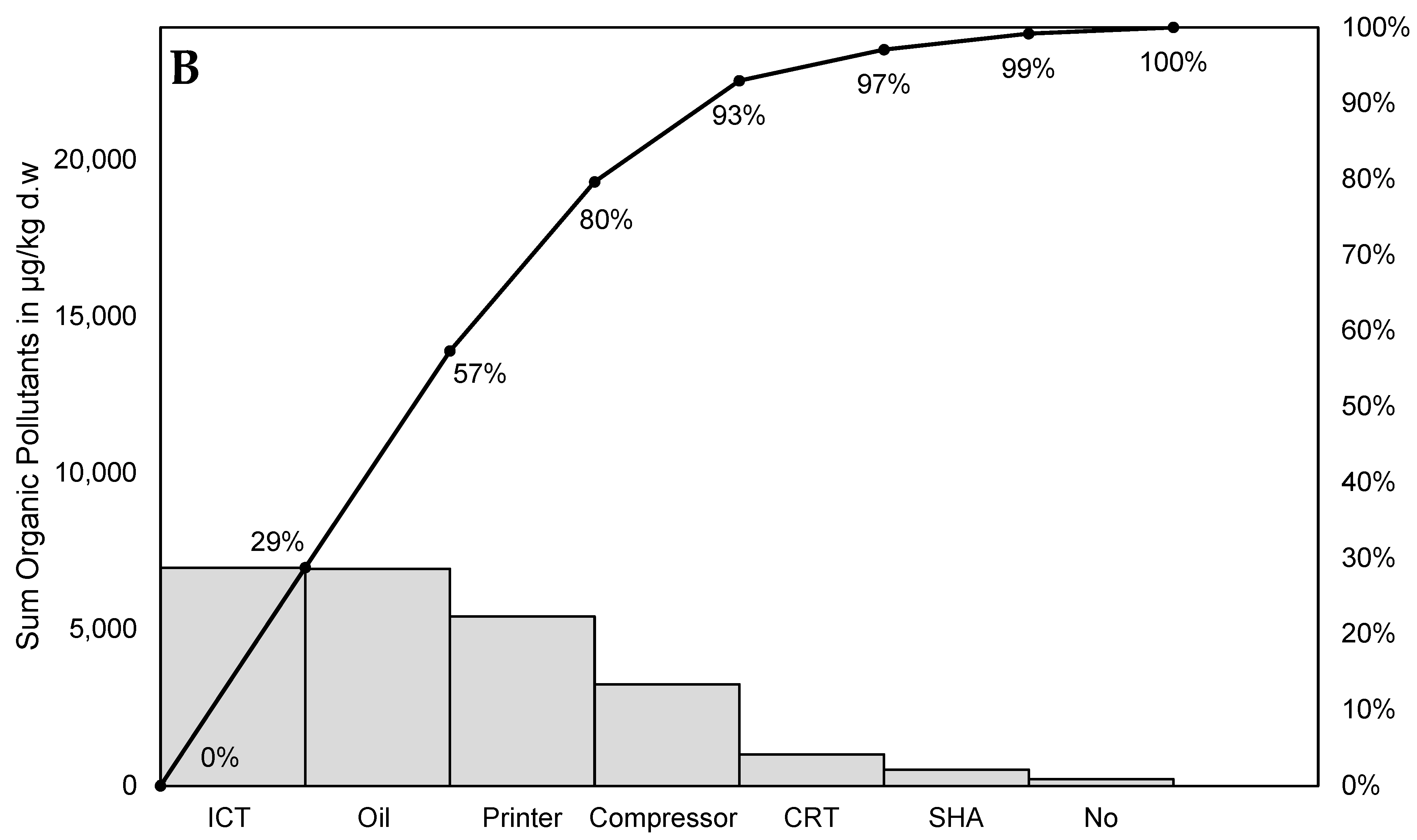
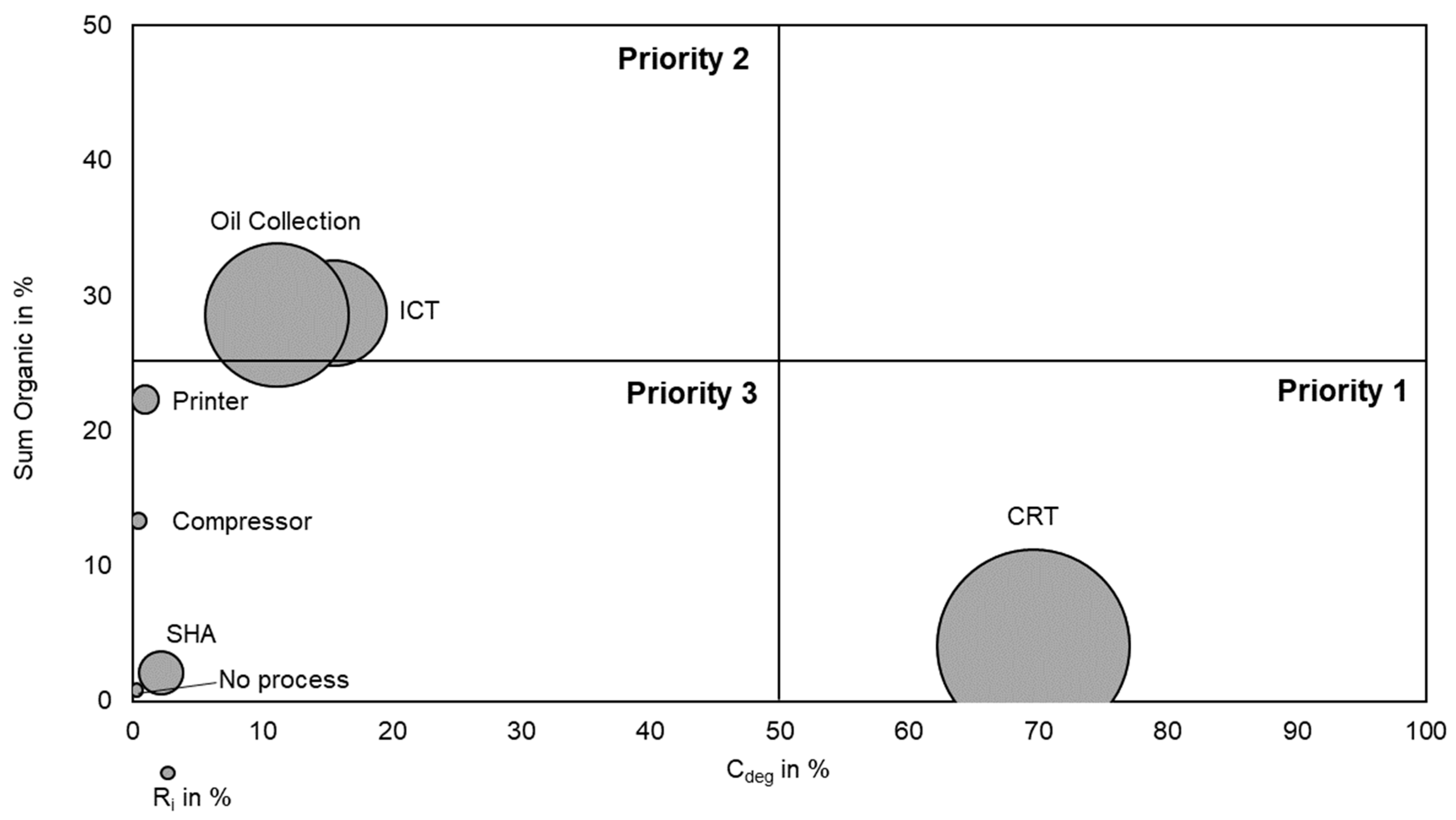
| Site | Assigned Main Process | Abbreviation | Main Activities | Influencing Activity | ||
|---|---|---|---|---|---|---|
| Burning | Landfill | Traffic | ||||
| 1 | Small household appliance dismantling | SHA | SHA and microwave dismantling | weak | weak | strong |
| 2 | No direct process | No | No dismantling activity, football pitch, soil layer renewed 2 years ago | strong | strong | no |
| 3 | Compressor dismantling | Compressor | Fridge and AC compressor dismantling | weak | weak | strong |
| 4 | Printer dismantling | Printer | Printer, smaller quantities of phones, and ICT dismantling | strong | strong | no |
| 5 | CRT dismantling | CRT | CRT dismantling | weak | no | no |
| 6 | ICT dismantling | ICT | ICT dismantling, mainly phones, laptops, PCs | strong | no | no |
| 7 | Oil collection workshop | Oil | Oil collection originating from cars and filling stations, e-waste | no | no | no |
| Site | Topsoil Sample | North | West | Sample Depth (m) |
|---|---|---|---|---|
| 1 | 1-b | 5°33′11.9″ N | 0°13′33.4″ W | 0.3 |
| 2 | 2-b | 5°33′14.0″ N | 0°13′35.5″ W | 0.3 |
| 3 | 3-b | 5°33′10.1″ N | 0°13′36.1″ W | 0.2 |
| 4 | 4-b | 5°33′11.0″ N | 0°13′38.1″ W | 0.1 |
| 5 | 5-b | 5°33′09.8″ N | 0°13′37.4″ W | 0.1 |
| 6 | 6-b | 5°33′06.4″ N | 0°13′33.5″ W | 0.05 |
| 7 | 7-b | 5°33′08.1″ N | 0°13′38.1″ W | 0.05 |
| Site | Lower Soil Sample | North | West | Sample Depth (m) |
| 1 | 1-S | 5°33′11.9″ N | 0°13′33.4″ W | 2.5 |
| 2 | 2-S | 5°33′14.0″ N | 0°13′35.5″ W | 2.2 |
| 3 | 3-S | 5°33′10.2″ N | 0°13′36.8″ W | 3.0 |
| 4 | 5-S | 5°33′14.7″ N | 0°13′38.0″ W | 2.3 |
| 5 | 4-S | 5°33′09.2″ N | 0°13′30.7″ W | 2.4 |
| 6 | 6-S | 5°33′06.4″ N | 0°13′33.5″ W | 2.5 |
| 7 | - | - | - | |
| Site | Water Sample | North | West | Groundwater Level (m) |
| 1 | 6-W | 5°33′12.2″ N | 0°13′33.2″ W | 1.3 |
| 2 | 5-W | 5°33′13.9″ N | 0°13′35.1″ W | 1.3 |
| 3 | 3-W | 5°33′07.9″ N | 0°13′33.7″ W | 1.6 |
| 4 | 1-W | 5°33′11.1″ N | 0°13′39.04″ W | 0.8 |
| 5 | 2-W | 5°33′09.8″ N | 0°13′37.4″ W | 0.4 |
| 6 | 4-W | 5°33′03.9″ N | 0°13′33.2″ W | 0.7 |
| Site No. | Soil Parameters | |||||||||
|---|---|---|---|---|---|---|---|---|---|---|
| Topsoil | Contamination Factor Cf | Degree of Cont. Cdeg | Classific. | |||||||
| Cr | Cu | Zn | As | Cd | Sb | Pb | Hg | |||
| 1 | 1.19 | 6 | 3.38 | 2.22 | 5.88 | 2.64 | 10.75 | 0.46 | 32.51 | Very high |
| 2 | 0.54 | 0.35 | 0.4 | 0.53 | 0.6 | 0.32 | 1.13 | 0.04 | 3.91 | Low |
| 3 | 0.69 | 0.63 | 0.88 | 1.07 | 0.92 | 0.71 | 1.05 | 0.11 | 6.04 | Low |
| 4 | 1.2 | 2.35 | 2.14 | 2.54 | 2.27 | 0.93 | 2.4 | 0.22 | 14.03 | Moderate |
| 5 | 2.4 | 802 | 23.1 | 4.53 | 39.69 | 130.5 | 31 | 0.45 | 1033.66 | Very high |
| 6 | 2.57 | 62.8 | 22.39 | 4.25 | 37.45 | 71 | 29.65 | 0.24 | 230.35 | Very high |
| 7 | 2.01 | 8.56 | 45.07 | 3.9 | 91.63 | 1.53 | 8.8 | 3.44 | 164.94 | Very high |
| Lower Soil | Contamination Factor Cf | Degree of Cont. Cdeg | Classific. | |||||||
| Mn | Cu | Zn | As | Co | Sb | Pb | Fe | |||
| 1 | 0.94 | 0.67 | 1.79 | 9.97 | 6.01 | 103.15 | 6.4 | 1.05 | 129.98 | Very high |
| 2 | 0.6 | 0.69 | 3.67 | 2.2 | 7.57 | 61.85 | 5.49 | 0.58 | 82.66 | Very high |
| 3 | 0.17 | 0.64 | 1.67 | 9.13 | 3.47 | 41.4 | 13.2 | 1.36 | 71.05 | Very high |
| 4 | 0.25 | 2.34 | 0 | 11.27 | 30.84 | 51 | 6.02 | 1.92 | 103.63 | Very high |
| 5 | 1.01 | 5.85 | 4.64 | 0 | 6.32 | 314.6 | 6.45 | 1.76 | 340.63 | Very high |
| 6 | 0.24 | 1.16 | 0.99 | 2.75 | 8.91 | 15.3 | 3.44 | 0.73 | 33.53 | Very high |
| Topsoil | Potential Ecological Risk Coefficient Er | Risk Index Ri | Classific. | |||||||
| Cr | Cu | Zn | As | Cd | Pb | Hg | ||||
| 1 | 2.38 | 30 | 3.38 | 22.2 | 176.33 | 53.75 | 18.48 | 306.51 | high | |
| 2 | 1.07 | 1.77 | 0.4 | 5.34 | 17.91 | 5.65 | 1.5 | 33.65 | low | |
| 3 | 1.39 | 3.16 | 0.88 | 10.67 | 27.49 | 5.23 | 4.22 | 53.02 | low | |
| 4 | 2.39 | 11.74 | 2.14 | 25.4 | 67.96 | 11.98 | 8.88 | 130.48 | low | |
| 5 | 4.79 | 4010 | 23.1 | 45.27 | 1190.82 | 155 | 17.84 | 5446.81 | significantly high | |
| 6 | 5.14 | 314 | 22.39 | 42.53 | 1123.47 | 148.25 | 9.44 | 1665.22 | significantly high | |
| 7 | 4.02 | 42.8 | 45.07 | 39 | 2748.98 | 44 | 137.6 | 3061.47 | significantly high | |
| Lower Soil | Potential Ecological Risk Coefficient Er | Risk Index Ri | Classific. | |||||||
| V | Cu | Zn | As | Sb | Pb | Co | ||||
| 1 | 2.17 | 3.34 | 1.79 | 99.67 | 722.05 | 32 | 30.07 | 891.07 | significantly high | |
| 2 | 2 | 3.47 | 3.67 | 22 | 432.95 | 27.47 | 37.84 | 529.4 | high | |
| 3 | 3.68 | 3.22 | 1.67 | 91.27 | 289.8 | 66.01 | 17.36 | 473.02 | high | |
| 4 | 7.64 | 11.7 | 0 | 112.67 | 357 | 30.12 | 154.2 | 673.32 | significantly high | |
| 5 | 1.62 | 29.24 | 4.64 | 0 | 2202.2 | 32.24 | 31.61 | 2301.54 | significantly high | |
| 6 | 2.73 | 5.82 | 0.99 | 27.53 | 107.1 | 17.22 | 44.57 | 205.96 | moderate | |
| Topsoil | Organic Parameters | |||||||||
| Sum CBs | Sum PCB7 | Sum PBDEs | Sum PAH16 | TOC | ||||||
| µg kg−1 | µg kg−1 | µg kg−1 | µg kg−1 | [%] d.w. | ||||||
| 1 | 44.67 | 26.35 | 29.25 | 407.06 | 1.34 | |||||
| 2 | 25.23 | 0.8 | 0.93 | 175.18 | 0.17 | |||||
| 3 | 48.84 | 1.49 | 6.84 | 3177.29 | 1.24 | |||||
| 4 | 12.78 | 1.49 | 40.59 | 5352.32 | 1.28 | |||||
| 5 | 56.78 | 6.5 | 123.72 | 802.01 | 3.97 | |||||
| 6 | 102.91 | 30.16 | 2451.48 | 4371.12 | 7.68 | |||||
| 7 | 238.25 | 202.07 | 22.49 | 6440.77 | 23.2 | |||||
| Water | Groundwater Parameters | |||||||||
| CCME WQI | HPI | Sum PCB | Sum PAH17 | |||||||
| µg L−1 | µg L−1 | |||||||||
| 1 | 33 | 149 | 0.09 | 0.81 | ||||||
| 2 | 40 | 189 | 0.07 | 0.22 | ||||||
| 3 | 26 | 394 | 0.08 | 0.75 | ||||||
| 4 | 25 | 464 | 0.14 | 1.76 | ||||||
| 5 | 28 | 65 | 0.09 | 1.45 | ||||||
| 6 | 30 | 168 | 0.09 | 0.28 | ||||||
| WQI | HPI | Ril | Rit | Cdegl | Cdegt | CBs | PCB7 | PBDEs | PAH16 | TOC | |
|---|---|---|---|---|---|---|---|---|---|---|---|
| WQI | 1.000 | ||||||||||
| HPI | −0.516 | 1.000 | |||||||||
| Ril | −0.337 | 0.530 | 1.000 | ||||||||
| Rit | −0.394 | 0.435 | 0.854 | 1.000 | |||||||
| Cdegl | −0.337 | 0.542 | 1.000 | 0.856 | 1.000 | ||||||
| Cdegt | −0.391 | 0.453 | 0.886 | 0.997 | 0.889 | 1.000 | |||||
| CBs | −0.110 | −0.379 | −0.082 | 0.387 | −0.087 | 0.320 | 1.000 | ||||
| PCB7 | 0.080 | −0.327 | −0.193 | 0.062 | −0.203 | −0.005 | 0.724 | 1.000 | |||
| PBDEs | −0.064 | −0.193 | −0.379 | 0.132 | −0.377 | 0.055 | 0.864 | 0.694 | 1.000 | ||
| PAH16 | −0.636 | 0.252 | −0.454 | −0.233 | −0.448 | −0.265 | 0.139 | 0.011 | 0.434 | 1.000 | |
| TOC | −0.318 | 0.012 | 0.018 | 0.508 | 0.019 | 0.439 | 0.912 | 0.651 | 0.910 | 0.349 | 1.000 |
Disclaimer/Publisher’s Note: The statements, opinions and data contained in all publications are solely those of the individual author(s) and contributor(s) and not of MDPI and/or the editor(s). MDPI and/or the editor(s) disclaim responsibility for any injury to people or property resulting from any ideas, methods, instructions or products referred to in the content. |
© 2024 by the authors. Licensee MDPI, Basel, Switzerland. This article is an open access article distributed under the terms and conditions of the Creative Commons Attribution (CC BY) license (https://creativecommons.org/licenses/by/4.0/).
Share and Cite
Owusu-Sekyere, K.; Aladago, D.A.; Leverenz, D.; Oteng-Ababio, M.; Kranert, M. Environmental Impacts on Soil and Groundwater of Informal E-Waste Recycling Processes in Ghana. Sustainability 2024, 16, 4347. https://doi.org/10.3390/su16114347
Owusu-Sekyere K, Aladago DA, Leverenz D, Oteng-Ababio M, Kranert M. Environmental Impacts on Soil and Groundwater of Informal E-Waste Recycling Processes in Ghana. Sustainability. 2024; 16(11):4347. https://doi.org/10.3390/su16114347
Chicago/Turabian StyleOwusu-Sekyere, Karoline, David Alatule Aladago, Dominik Leverenz, Martin Oteng-Ababio, and Martin Kranert. 2024. "Environmental Impacts on Soil and Groundwater of Informal E-Waste Recycling Processes in Ghana" Sustainability 16, no. 11: 4347. https://doi.org/10.3390/su16114347
APA StyleOwusu-Sekyere, K., Aladago, D. A., Leverenz, D., Oteng-Ababio, M., & Kranert, M. (2024). Environmental Impacts on Soil and Groundwater of Informal E-Waste Recycling Processes in Ghana. Sustainability, 16(11), 4347. https://doi.org/10.3390/su16114347








